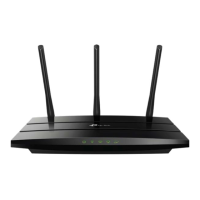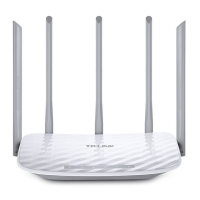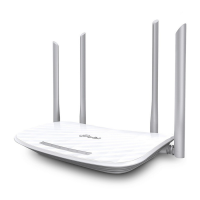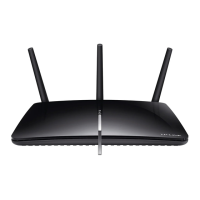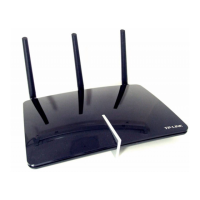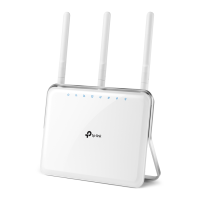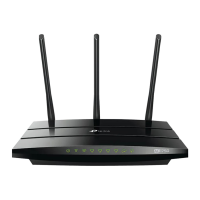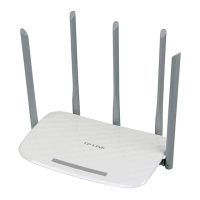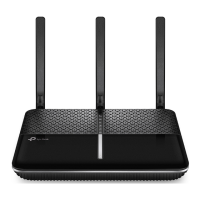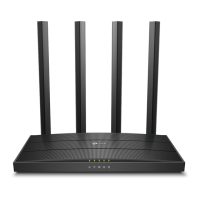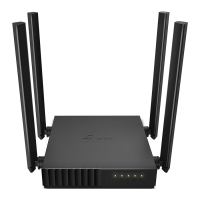Do you have a question about the TP-Link Archer GX90 and is the answer not in the manual?
Provides a general overview of the router's features and capabilities.
Details the physical appearance and components of the router.
Guidance on selecting an optimal location for the router.
Step-by-step instructions for physically connecting the router.
Guides users through the initial router setup process for internet connectivity.
Explains how to set up the router using the TP-Link Tether mobile application.
Details manual configuration of internet connection settings based on ISP information.
Configures the router to function as an access point for an existing wired network.
Provides instructions for setting up an IPv6 internet connection.
Step-by-step guide to creating a TP-Link ID for cloud management.
Instructions for modifying the email address and password associated with a TP-Link ID.
Explains how to add or remove other TP-Link IDs for managing the router as users.
Describes how to manage the router using the TP-Link Tether mobile application.
How to set up a separate Wi-Fi network for guests.
Options to control guest access and privacy settings.
Instructions on how to insert and access USB storage devices connected to the router.
Enables viewing photos, playing music, and watching movies from USB storage via DLNA.
Configuration for backing up Mac data to a USB storage device using Time Machine.
Set restrictions on internet access, content, and time for family members.
Prioritize internet traffic for specific activities or devices to ensure smooth performance.
Built-in protection against malicious content and network intrusions.
General advice on securing the network against online threats.
Configure rules to control which devices can access the network.
Binds IP addresses to MAC addresses to prevent unauthorized network access.
Allows access to specific services on your local network from the internet.
Automatically opens ports when specific outbound traffic is detected.
Exposes a device to the internet with all ports open.
Enables Universal Plug and Play for automatic port configuration for games.
Sets up an OpenVPN server for secure remote access to the home network.
Configures a PPTP VPN server for remote access to the home network.
Modifies the router's local area network (LAN) IP address and subnet mask.
Combines multiple network connections to increase bandwidth.
Sets up the router to work with Internet Protocol Television (IPTV) services.
Configures the Dynamic Host Configuration Protocol (DHCP) server for automatic IP assignment.
Configures DDNS to access the router using a domain name.
Manually defines routes for network traffic.
Customizes wireless network name (SSID), security, and other parameters.
Sets specific times for the wireless network to be enabled or disabled.
Connects devices to the Wi-Fi network using Wi-Fi Protected Setup (WPS).
Instructions for updating the router's firmware to the latest version.
How to save and load router configuration settings.
Steps to change the router's administrative login password.
Procedures for recovering the router's login password if forgotten.
Manages the router's settings from within the local network.
Configures settings for managing the router from outside the local network.
Accesses logs to monitor router events and troubleshoot issues.
Tools to check and diagnose network connection status.
Configures the router's internal clock and time zone.
Schedules automatic router reboots for maintenance.
Manages the router's LED indicators, such as turning them on or off.
Performs a speed test to measure internet connection performance.
View important network and gaming-related parameters on the dashboard.
Optimizes network performance for gaming sessions.
Integrates the router with Amazon Alexa for voice control.
Provides security features specifically for online gaming.
Sets up a VPN server for secure access to the home network.
Allows external access to specific ports on devices within the local network.
Tools for diagnosing network issues affecting online gaming.
Provides a general overview of the router's features and capabilities.
Details the physical appearance and components of the router.
Guidance on selecting an optimal location for the router.
Step-by-step instructions for physically connecting the router.
Guides users through the initial router setup process for internet connectivity.
Explains how to set up the router using the TP-Link Tether mobile application.
Details manual configuration of internet connection settings based on ISP information.
Configures the router to function as an access point for an existing wired network.
Provides instructions for setting up an IPv6 internet connection.
Step-by-step guide to creating a TP-Link ID for cloud management.
Instructions for modifying the email address and password associated with a TP-Link ID.
Explains how to add or remove other TP-Link IDs for managing the router as users.
Describes how to manage the router using the TP-Link Tether mobile application.
How to set up a separate Wi-Fi network for guests.
Options to control guest access and privacy settings.
Instructions on how to insert and access USB storage devices connected to the router.
Enables viewing photos, playing music, and watching movies from USB storage via DLNA.
Configuration for backing up Mac data to a USB storage device using Time Machine.
Set restrictions on internet access, content, and time for family members.
Prioritize internet traffic for specific activities or devices to ensure smooth performance.
Built-in protection against malicious content and network intrusions.
General advice on securing the network against online threats.
Configure rules to control which devices can access the network.
Binds IP addresses to MAC addresses to prevent unauthorized network access.
Allows access to specific services on your local network from the internet.
Automatically opens ports when specific outbound traffic is detected.
Exposes a device to the internet with all ports open.
Enables Universal Plug and Play for automatic port configuration for games.
Sets up an OpenVPN server for secure remote access to the home network.
Configures a PPTP VPN server for remote access to the home network.
Modifies the router's local area network (LAN) IP address and subnet mask.
Combines multiple network connections to increase bandwidth.
Sets up the router to work with Internet Protocol Television (IPTV) services.
Configures the Dynamic Host Configuration Protocol (DHCP) server for automatic IP assignment.
Configures DDNS to access the router using a domain name.
Manually defines routes for network traffic.
Customizes wireless network name (SSID), security, and other parameters.
Sets specific times for the wireless network to be enabled or disabled.
Connects devices to the Wi-Fi network using Wi-Fi Protected Setup (WPS).
Instructions for updating the router's firmware to the latest version.
How to save and load router configuration settings.
Steps to change the router's administrative login password.
Procedures for recovering the router's login password if forgotten.
Manages the router's settings from within the local network.
Configures settings for managing the router from outside the local network.
Accesses logs to monitor router events and troubleshoot issues.
Tools to check and diagnose network connection status.
Configures the router's internal clock and time zone.
Schedules automatic router reboots for maintenance.
Manages the router's LED indicators, such as turning them on or off.
Performs a speed test to measure internet connection performance.
View important network and gaming-related parameters on the dashboard.
Optimizes network performance for gaming sessions.
Integrates the router with Amazon Alexa for voice control.
Provides security features specifically for online gaming.
Sets up a VPN server for secure access to the home network.
Allows external access to specific ports on devices within the local network.
Tools for diagnosing network issues affecting online gaming.
| DSL WAN | No |
|---|---|
| Ethernet WAN | Yes |
| WAN connection type | RJ-45 |
| Product type | Tabletop router |
| Product color | Black, Red |
| LED indicators | LAN, Power, WLAN |
| Wi-Fi band | Tri-band (2.4 GHz / 5 GHz / 5 GHz) |
| Wi-Fi standards | 802.11a, 802.11b, 802.11g, Wi-Fi 4 (802.11n), Wi-Fi 5 (802.11ac), Wi-Fi 6 (802.11ax) |
| Top Wi-Fi standard | Wi-Fi 6 (802.11ax) |
| WLAN data transfer rate (max) | 6600 Mbit/s |
| WLAN data transfer rate (first band) | 4804 Mbit/s |
| WLAN data transfer rate (third band) | 574 Mbit/s |
| WLAN data transfer rate (second band) | 1201 Mbit/s |
| Antennas quantity | 4 |
| VPN server | OpenVPN, PPTP |
| Cabling technology | 10/100/1000Base-T(X) |
| Networking standards | IEEE 802.11a, IEEE 802.11ac, IEEE 802.11ax, IEEE 802.11b, IEEE 802.11g, IEEE 802.11n |
| Ethernet LAN data rates | 10, 100, 1000 Mbit/s |
| Ethernet LAN interface type | Gigabit Ethernet |
| Number of guest networks (5 GHz) | 1 |
| Certification | FCC, CE, RoHS |
| Processor frequency | 1500 MHz |
| Output current | 5 A |
| Output voltage | 12 V |
| Power source type | DC |
| Storage temperature (T-T) | -40 - 70 °C |
| Operating temperature (T-T) | 0 - 40 °C |
| Storage relative humidity (H-H) | 5 - 90 % |
| Operating relative humidity (H-H) | 10 - 90 % |
| USB 2.0 ports quantity | USB 2.0 ports have a data transmission speed of 480 Mbps, and are backwards compatible with USB 1.1 ports. You can connect all kinds of peripheral devices to them. |
| Ethernet LAN (RJ-45) ports | 5 |
| Cables included | LAN (RJ-45) |
| Supported network protocols | IPv4, IPv6 |
| Harmonized System (HS) code | 85176990 |
| Width | 212 mm |
|---|---|
| Height | 51.8 mm |

